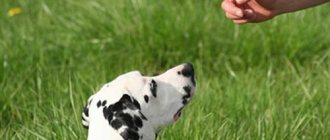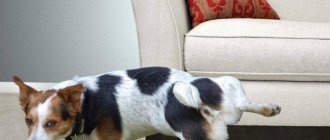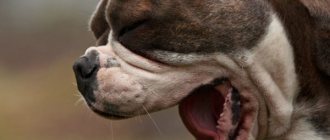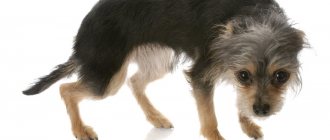Dogs are active, so they tolerate paw injuries very poorly. Let's take a closer look at what a dislocated knee, hip joint, or shoulder in a dog is, their symptoms and treatment. These are the most common consequences of injuries, slips, impacts and falls. It is a displacement of the bones of the joint. This affects soft tissue structures.
The disease causes dysfunction of the limb. This leads to pain or lameness. Dislocation can be complete - it often appears as a result of injury. Incomplete, that is, subluxation, also occurs. Usually this pathology is congenital.
What is a dislocation?
Dislocation is a displacement of bone structures with disruption of tissue integrity. In this case, blood vessels and cartilaginous structures are damaged. The ligaments of the joint and tendon are affected.
A breed predisposition is observed in breeds such as miniature poodles, Yorkies, Chihuahuas, lapdogs, and Pekingese. Among representatives of large breeds, the disease more often affects St. Bernards, Labradors, and Malamutes. But if the dog is not at risk for birth defects, the disease may develop.
If you do not start therapy on time, there is a risk of the following consequences:
- The pet suffers from pain, so it may be aggressive and disobey its owner.
- The joint will recover on its own, but an unfixed paw runs the risk of healing incorrectly, which in the future may have a negative impact on the dog’s pace of life.
- Along with the dislocation, the inflammatory process begins and swelling appears. This causes gangrene and limb loss.
- Ligament rupture may occur. The pet will stop moving its paw, and muscle atrophy will occur, that is, paralysis.
Patella luxation
This type of dislocation most often occurs in small and dwarf breeds of dogs, such as terriers and Spitz, poodles, as they have a genetic predisposition to such a dislocation.
Dislocation of the calyx as a result of injury occurs in larger breeds of dogs. Also, the displacement of the kneecap is often associated with age-related changes, since closer to old age the muscles of the body weaken and this type of injury is possible.
When a dog's kneecap dislocates, it can move both outward and inward - if the kneecap moves toward the abdomen, then this type is called a lateral dislocation, and in the opposite direction from the abdomen, it is a medial dislocation.
Types of dislocations that a dog can have
According to etiology, dislocations are divided into the following types:
- Congenital. Damage occurs in the womb, and as a result, the pet is born with an illness. If he is viable, supportive treatment is prescribed. But recovery doesn't happen often.
- Paralytic. The muscles supporting the joint atrophy.
- Pathological. Appears when there are problems with the musculoskeletal system, thinning of cartilage and bone tissue.
- Traumatic. The reason is due to a fall, impact and difficulties during childbirth of the offspring.
- Habitual. If the muscles and ligaments are sprained once, the joint will be poorly supported. Because of this, under load, dislocation will occur again.
- Complicated. When the bone is displaced, nerve endings and blood vessels are affected.
- Unguided. This group includes chronic dislocations and the appearance of new tissue between the articular heads.
By time of injury:
- fresh. The pathology was detected no later than three days after the onset of the dislocation;
- stale. Three days to two weeks passed;
- outdated. The injury occurred 2-3 weeks ago.
Type:
- closed. External tissues and skin are not affected;
- open. There is no fracture, but there is visible tearing of the skin and muscles.
By degree:
- Subluxation. There was a partial rupture of the articular tissues, the articular capsule was not affected. Movements cause pain, but the pet can walk.
- Full. The bone is displaced, a rupture of the joint capsule and divergence of the joint is observed.
Causes and types
At its core, a dislocation is a displacement of the articular heads of bones relative to each other, and a sprain is partial damage to the ligaments surrounding the joint with micro-tears of individual fibers. There are 2 main groups of factors that provoke a sprained or dislocated paw in a dog:
- traumatic - associated with injuries resulting from a fall from a great height, an accident, active games or injury during childbirth;
- congenital – caused by pathologies of intrauterine development of the fetus during pregnancy.
In addition, according to etiology, limb dislocations are divided into the following types:
Signs and symptoms of injury
The owner can identify pathology in the joint by the following manifestations:
- Reluctance to step on injured paw. Lameness appears, unnatural postures are observed. The pet is trying to move on three limbs.
- A dislocated front paw is distinguished by the fact that the dog pulls it under itself. With a hip injury, it is difficult for a pet to get up after lying for a long time.
- The affected organ changes shape due to tissue swelling. The joint becomes swollen.
- The dog moves his paw with difficulty. He tries to hold her, guiding her inside.
- Each touch, especially palpation, leads to intense pain. This can cause the dog to become aggressive. She growls, whines, tries to run away from her owner, and even bites.
Sometimes you can hear the bone rubbing against the joint. There is a noticeable grinding and clicking sound.
Owners of Spitz and Yorkshire terriers often complain to the veterinarian about the lameness of their pets. The usual cause is medial luxation of the patella. The disease is characterized by displacement of the joint inward, sometimes outward (lateral). The latter pathology is diagnosed in 25 percent of cases.
Doctors distinguish four degrees of knee dislocation (patellar dislocation) in a dog. The most dangerous is the last degree. With it, the cup will not adjust without help. The main symptom of the pathology is lameness. To identify an injury, an x-ray of the joint should be taken.
Hip dislocation is the most common type. In this case, the head of the femur is displaced from the acetabulum. The round ligament often ruptures.
Lameness is severe. The pet does not step on the affected limb and presses it inward. Intense pain when a hip is dislocated leads to the dog refusing to eat, becoming indifferent and lethargic.
A dislocated shoulder in a dog is expressed as a displacement of the scapula from the shoulder joint. Lameness is also noticeable. Occurs most often in small breeds and is usually caused by injury.
Due to a dislocation of the forelimb, the pet's gait changes noticeably. He collapses and sometimes it is difficult to understand which specific paw is affected. Similar signs are noticeable in a number of other diseases. You should immediately take him to the doctor so that he can determine if the dog has a dislocation or sprain of the front paw.
If the problem is with the hind leg, the pain is very intense. The pet does not step on the injured limb, and it is difficult for him to get up. It can be confused with hip dysplasia.
A jaw injury often appears after learning the “Face” command or after injury to the head. In this case, the pet cannot close its mouth and drools profusely.
How to provide first aid to a pet?
Owners often have a question about how to fix a dislocated pet on their own. But doctors do not advise treating a dog at home in this way. There is a risk of confusing the pathology, because it could be a crack, a closed fracture. The process also causes intense pain. If done incorrectly and without the use of painkillers, the dog may experience traumatic shock.
First, you should immobilize the sore paw. The dog should be left in a fenced area, such as a crate. Miniature breeds should be placed in a small box or carrier. It is worth putting a leash on a large dog so that it moves less.
Massaging or kneading the limb is prohibited. If possible, avoid turning your dog over. If the injury appears in front of the owner, you can apply ice or frozen food in a napkin to the affected area. It is not worth giving food, because there is a possibility of anesthesia being administered in the hospital.
If the pet is injured and there is a suspicion of a dislocation, the owner can take the following measures:
- Do not panic, as the injury is not considered fatal.
- After providing first aid, take your pet to the clinic or call a doctor.
- Carry out a careful inspection. It is worth making sure that there are no tissue tears and the pet can walk. If the hip joint is damaged, movement is prohibited. You will need to calm the dog by holding it in a lying position on its side. The affected joint should be on top.
- Put on a muzzle. Even the kindest and most docile animal shows aggression due to intense pain.
- If necessary, the dog is moved using a stretcher or a well-stretched blanket.
- To fix the joint with a bandage, do not use a thick wrap. It tightens as you wear it. It is better to apply a soft splint, securing the paw below or above the damaged area.
- Wrap the swollen area with film and material in several layers. After putting ice or a frozen product, this will relieve pain and prevent hemorrhage.
- Observe the temperature of the fixed paw. If the limb has become cooler, it is worth making the bandage less tight.
- You should not expect a diagnosis and treatment recommendations from your doctor over the phone. The pathology must be confirmed by x-ray or by palpation if the patella is damaged.
- If your pet howls and whines, you should give an anesthetic injection. In the case where there are no allergic or other reactions, you can choose “Ketanov”, “Rimadyl”, “Baralgin”. "Analgin" is chosen if the introduction of other drugs is impossible. If side effects have already been observed when using these drugs, the universal medicine “Travmatin” is suitable.
- You need to choose half the dosage based on the pet’s weight. It is important for him to experience pain, otherwise he will begin to lean on his paws, which will worsen the situation.
First aid
If your dog shows symptoms of a dislocation, you should not panic, since the injury, although serious, is not life-threatening if treated in a timely manner. The main thing is to provide first aid correctly and immediately call a veterinarian or take the animal to the clinic.
First of all, you need to put a muzzle on your pet, since any dog in pain shock can become aggressive and unpredictable. Then the algorithm of actions should be as follows:
- carefully lay the pet down with the damaged joint facing up and inspect for tissue tears;
- do not allow him to walk, but, if necessary, carry him on a stretcher or blanket;
- fix the joint with an elastic bandage, ideally with the application of a soft splint with fastening above and below the joint;
- wrap the injured area with film, then with cloth and apply cold.
You can’t straighten a dog’s dislocated paw yourself! Improper actions can cause significant harm and cause severe pain to the animal, especially if the injury is accompanied by ligament rupture and internal bleeding.
Before contacting a veterinarian, it is necessary to monitor the temperature of the limb with a fixing bandage. If she gets cold, then the bandage should be loosened.
Treatment of dislocation in a dog
For this purpose, surgical and conservative methods are used. Non-surgical treatment is considered to be organ repositioning. First, anesthesia is administered, then the joint is returned to its correct position. Afterwards it is necessary to fix it for 21 days with immobilizing bandages. Sometimes the doctor may advise leaving the pet for several days in a small room, cage or box.
You can speed up the healing process with anti-inflammatory drugs, vitamins and chondroprotectors. Physiotherapy methods such as heat therapy and massage will help. During the recovery period of the dog after a dislocation, light exercise and swimming in warm water are allowed.
Complications such as relapse often occur. This happens two weeks after the first dislocation. Then surgery is required. The specialist restores the round ligament, performs interarticular fastening, and repairs the joint capsule. It is possible to replace it with a biosynthetic prosthesis.
If the hip joint is damaged, if the femoral head prevents it from returning to the desired position, the doctor may remove it. The dog develops a “false joint”, allowing the paw to function normally.
Proper care after surgery is important. Some dislocations sometimes require a hock joint brace and the use of anti-inflammatory drugs. Chondroprotectors, calcium, vitamin D, Dexamethasone, and Prednisolone have a beneficial effect on the recovery process. A swimming pool, extended periods of time outside and light exercise will help your pet heal faster. Animals up to 25 kg do not recover for very long after a hip dislocation.
Video: dislocation in dogs, its symptoms and treatment
How to protect your pet from injury?
To ensure prevention against dislocations, the following rules must be observed:
- Use nutritional supplements (Chondroitin, Glucosamine) to prevent illness in puppies and young animals.
- Make sure your dog does not gain excess weight. In this case, the likelihood of injury will increase.
- Avoid excessive physical exertion, which can cause dislocations.
There is no need to try to solve the problem yourself if an injury occurs. It is necessary to take your dog to the doctor as soon as possible.











